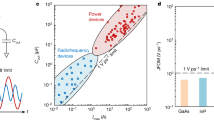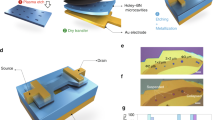Abstract
Nanoelectromechanical (NEM) switches1,2,3,4,5,6 have received widespread attention as promising candidates in the drive to surmount the physical limitations currently faced by complementary metal oxide semiconductor technology. The NEM switch has demonstrated superior characteristics including quasi-zero leakage behaviour1, excellent density capability2 and operation in harsh environments3. However, an unacceptably high operating voltage (4–20 V) has posed a major obstacle in the practical use of the NEM switch in low-power integrated circuits. To utilize the NEM switch widely as a core device component in ultralow power applications7,8,9,10,11, the operation voltage needs to be reduced to 1 V or below. However, sub-1 V actuation has not yet been demonstrated because of fabrication difficulties and irreversible switching failure caused by surface adhesion. Here, we report the sub-1 V operation of a NEM switch through the introduction of a novel pipe clip device structure and an effective air gap fabrication technique. This achievement is primarily attributed to the incorporation of a 4-nm-thick air gap, which is the smallest reported so far for a NEM switch generated using a ‘top-down’ approach. Our structure and process can potentially be utilized in various nanogap-related applications, including NEM switch-based ultralow-power integrated circuits, NEM resonators12,13, nanogap electrodes for scientific research14 and sensors15.
This is a preview of subscription content, access via your institution
Access options
Subscribe to this journal
Receive 12 print issues and online access
$259.00 per year
only $21.58 per issue
Buy this article
- Purchase on Springer Link
- Instant access to full article PDF
Prices may be subject to local taxes which are calculated during checkout




Similar content being viewed by others
References
Jang, J. E. et al. Nanoscale memory cell based on a nanoelectromechanical switched capacitor. Nature Nanotech. 3, 26–30 (2008).
Rueckes, T. et al. Carbon nanotube-based nonvolatile random access memory for molecular computing. Science 289, 94–97 (2000).
Lee, T-H., Bhunia, S. & Mehregany, M. Electromechanical computing at 500 °C with silicon carbide. Science 329, 1316–1318 (2010).
Lee, S. W. et al. A three-terminal carbon nanorelay. Nano. Lett. 4, 2027–2030 (2004).
Jang, W. W. et al. Fabrication and characterization of a nanoelectromechanical switch with 15-nm-thick suspension air gap. Appl. Phys. Lett. 92, 103110 (2008).
Lee, S. W., Park, S. J., Campbell, E. E. B. & Park, Y. W. A fast and low-power microelectromechanical system-based non-volatile memory device. Nature Commun. 2, 220 (2010).
Raghunathan, V., Kansal, A., Hsu, J., Friedman, J. & Srivastava, M. Design considerations for solar energy harvesting wireless embedded systems. Proc. IPSN, 457–462 (2005).
Service, R. F. Nanogenerators tap waste energy to power ultrasmall electronics. Science 328, 304–305 (2010).
Xu, S. et al. Self-powered nanowire devices. Nature Nanotech. 5, 366–373 (2010).
Tian, B. Z. et al. Coaxial silicon nanowires as solar cells and nanoelectronic power sources. Nature 449, 885–890 (2007).
Yang, R., Qin, Y., Dai, L. & Wang, Z. L. Power generation with laterally packaged piezoelectric fine wires. Nature Nanotech. 4, 34–39 (2009).
Naik, A. K., Hanay, M. S., Hiebert, W. K., Feng, X. L. & Roukes, M. L. Towards single-molecule nanomechanical mass spectrometry. Nature Nanotech. 4, 445–450 (2009).
Ekinci, K. L. & Roukes, M. L. Nanoelectromechanical systems. Rev. Sci. Instrum. 76, 061101 (2005).
Ward, D. R., Hűser, F., Pauly, F., Cuevas, J. C. & Natelson, D. Optical rectification and field enhancement in a plasmonic nanogap. Nature Nanotech. 5, 732–736 (2010).
Im, H., Huang, X-J., Gu, B. & Choi, Y-K. A dielectric-modulated field-effect transistor for biosensing. Nature Nanotech. 2, 430–434 (2007).
Rebeiz, G. M. RF MEMS: Theory, Design and Technology (Wiley, 2003).
Akarvardar, K. et al. Design considerations for complementary nanoelectromechanical logic gates. IEEE IEDM Tech. Digest, 299–302 (2007).
Loh, O. Y. & Espinosa, H. D. Nanoelectromechanical contact switches. Nature Nanotech. 7, 283–295 (2012).
Dussopt, L. & Rebeiz, G. M. Intermodulation distortion and power handling in RF MEMS switches, varactors and tunable filters. IEEE Trans. Microw. Theory Tech. 51, 1247–1256 (2003).
Choi, W. Y., Kam, H., Lee, D., Lai, J. & King, T-J. Compact nanoelectro-mechanical non-volatile memory (NEMory) for 3D integration. IEEE IEDM Tech. Digest, 603–606 (2007).
Choi, S-J. et al. Transformable functional nanoscale building blocks with wafer-scale silicon nanowires. Nano Lett. 11, 854–859 (2011).
Li, B. T., Hu, W. & Zhu, D. Nanogap electrodes. Adv. Mater. 22, 286–300 (2010).
Johnston, D. E., Strachan, D. R. & Johnson, A. T. C. Parallel fabrication of nanogap electrodes. Nano Lett. 7, 2774–2777 (2007).
Yasutake, Y. et al. Simultaneous fabrication of nanogap gold electrodes by electroless gold plating using a common medical liquid. Appl. Phys. Lett. 91, 203107 (2007).
Choi, Y-K., King, T-J. & Hu, C. Nanoscale CMOS spacer FinFET for the terabit era. IEEE Electron. Dev. Lett. 23, 25–27 (2002).
Horstmann, J. T., Hilleringmnn, U. & Goser, K. F. Matching analysis of deposition defined 50-nm MOSFET. IEEE Trans. Electron. Dev. 45, 299–306 (1998).
Stern, E. et al. Label-free immunodetection with CMOS-compatible semiconducting nanowires. Nature 445, 519–522 (2007).
Mungekar, H. P. & Lee, Y. S. High density plasma chemical vapor deposition gap-fill mechanisms. J. Vac. Sci. Technol. B 24, L11 (2006).
Davidson, B. D., Seghete, D., George, S. M. & Bright, V. M. ALD tungsten NEMS switches and tunneling devices. Sens. Actuat. A 166, 269–276 (2011).
Lee, J. O. et al. 3-terminal nanoelectromechanical switching device in insulating liquid media for low voltage operation and reliability improvement. IEEE IEDM Tech. Digest, 227–230 (2009).
Acknowledgements
This work was supported by the Smart IT Convergence System Research Center, which is funded by the Ministry of Education, Science and Technology as a Global Frontier Project, and also partially supported by the National Research Foundation of Korea (NRF) grant funded by the Korea government (MEST) (no. 20120000823). The authors would like to thank Yang-Kyu Choi for experimental support.
Author information
Authors and Affiliations
Contributions
J.O.L. conceived the idea and performed experimental work and data analysis. M-H.K. and J-S.O. contributed to the fabrication process. J.O.L., M-W.K. and Y-H.S. performed modelling and interpretation. H-H.Y. participated in data analysis. J-B.Y. inspired the research, with guidance, and participated in data analysis. The manuscript was written by J.O.L. and J-B.Y. All authors discussed the results and commented on the manuscript.
Corresponding author
Ethics declarations
Competing interests
The authors declare no competing financial interests.
Supplementary information
Supplementary information
Supplementary information (PDF 2428 kb)
Rights and permissions
About this article
Cite this article
Lee, J., Song, YH., Kim, MW. et al. A sub-1-volt nanoelectromechanical switching device. Nature Nanotech 8, 36–40 (2013). https://doi.org/10.1038/nnano.2012.208
Received:
Accepted:
Published:
Issue Date:
DOI: https://doi.org/10.1038/nnano.2012.208
This article is cited by
-
An interconnect-free micro-electromechanical 7-bit arithmetic device for multi-operand programmable computing
Microsystems & Nanoengineering (2023)
-
Sub-10 fJ/bit radiation-hard nanoelectromechanical non-volatile memory
Nature Communications (2023)
-
Intermittent failure mechanism and stabilization of microscale electrical contact
Friction (2023)
-
Controlled nano-cracking actuated by an in-plane voltage
Science China Information Sciences (2021)
-
Nanoelectromechanical relay without pull-in instability for high-temperature non-volatile memory
Nature Communications (2020)



